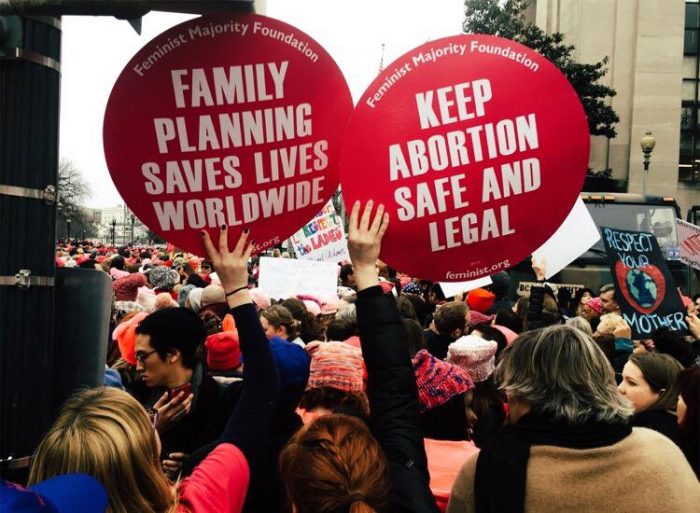 A disturbing statistic has become a major talking point in Texas political campaigns this election cycle. From state house races to the fight for Ted Cruz’s senate seat, candidates are making maternal mortality a component of every healthcare discussion, and it’s a conversation that’s seriously needed. Between 2010 and 2012, Texas’s maternal mortality rate nearly doubled to 35.8 per 100,000 births, passing every other state and many developed countries, and practically nothing has been done to address the crisis since.
A disturbing statistic has become a major talking point in Texas political campaigns this election cycle. From state house races to the fight for Ted Cruz’s senate seat, candidates are making maternal mortality a component of every healthcare discussion, and it’s a conversation that’s seriously needed. Between 2010 and 2012, Texas’s maternal mortality rate nearly doubled to 35.8 per 100,000 births, passing every other state and many developed countries, and practically nothing has been done to address the crisis since.
The statistic comes from a September 2016 report examining United States maternal mortality rates from 2000-2014 by the journal Obstetrics & Gynecology, and the authors noted an unusual abnormality when it came to Texas. They found that the Texas maternal mortality rate increased modestly from 2000-2010 before nearly doubling over a 2-year period. This increase could not be explained by changes in reporting; there were no natural disasters, no severe economic stresses, and no other major factors that could easily explain this change.
The doubling of Texas’s maternal mortality rate coincided with the legislature’s passage of destructive anti-women legislation that has dramatically decreased access to reproductive health care in the state. The first wave of legislation began in 2011 when Texas cut funding to state family planning initiatives from $111 million to $37.9 million. In addition, the Texas legislature voted to violate federal law and exclude Planned Parenthood and other abortion providers from receiving federal funding from the Medicaid Women’s Health Program. When the state refused to comply with federal law, the Obama administration was forced to revoke the state’s federal Medicaid funding for family planning, leading to an even greater reduction in resources.
Since then, 82 clinics have ended their family planning services or been forced to close completely. Before the 2011 votes, Planned Parenthood’s 81 clinics provided care to over 40% of women in the Medicaid Women’s Health program; they are now down to only 35 clinics, only five of which provide abortion care, leaving many rural Texas communities and Texans of color vulnerable.

Texas’s state funded healthcare program for low-income women has changed names three times in the last six years, from the Medicaid Women’s Health Program to the Texas Women’s Health Program to the Healthy Texas Women program. Each name change corresponds with increasing numbers of closed clinics and decreased numbers of women in the program who actually receive health care. In 2016, 1 in 4 of the women enrolled in the Texas Women’s Health/Healthy Texas Women program did not receive care from any provider; when Planned Parenthood and other family planning clinics were part of the program, only 1 in 10 women enrolled did not receive care. Furthermore, the number of women receiving contraceptives through this program has decreased by 41% since 2011.
Texas claims that they are working to address the destruction of women’s health and family planning programs that has coincided with the disturbingly high maternal mortality rate, but their actions have proved otherwise. In 2013, the Texas state legislature established the Maternal Mortality Task Force. This Task Force released their first report in July 2016, which focuses on the 189 maternal mortality deaths that occurred in 2011-2012 and reveals several concerning facts.
First, the Task Force found that black women disproportionately die from pregnancy-related causes – black women suffered 28.4% of the state’s maternal deaths but accounted for only 11.4% of all births. The Task Force determined that the top three causes of maternal mortalities were cardiac events, overdose by prescription drugs, and hypertensive disorders, respectively. 60% of the deaths occurred past the 42nd day after delivery, displaying the importance of continuity of care.
In their report, the Maternal Mortality Task Force also provided several policy and education recommendations. One of their recommendations was to increase access to health services during the year after delivery and between pregnancies in order to improve continuity of care. They hoped that this increased access would promote safe birth spacing and reduce maternal morbidity. Ultimately, this increased access would reduce the cost of care for Medicaid patients as less risky births cost less money. Another recommendation was to increase provider and community awareness of healthcare disparities and develop programs that give more women the ability to self-advocate.
The Task Force’s recommendations provide clear steps for working towards the solution to the maternal mortality crisis in Texas. However, the Texas legislature, in its most recent session, appears to have completely ignored these recommendations and, in fact, has passed bills that could make the problem worse by increasing unintended pregnancies. Texas’s recent legislation involves abortion restrictions. These bills include a requirement for the burial or cremation of fetal remains and a ban on “dilation and evacuation” procedures, effectively banning abortion after the first trimester. In addition, a new state law restricts insurance coverage of abortions and mandates that women have to buy supplemental insurance if they think they might ever want or need an abortion procedure.

Texas’s refusal to comply with federal law and fund Planned Parenthood providers also goes against the Task Force’s recommendations. Texas has the highest birth rate in the United States, and Medicaid pays for more than half of all births in the state. By cutting out Planned Parenthood and other abortion providers from Texas’s health program for low-income women, legislators have denied the state funding for crucial services and shown that they are not serious about address the disparity in maternal health care. Texas is now asking the Trump administration to excuse the state’s violation of federal law and reinstate Medicaid funding nonetheless, which could set a dangerous precedent for other states who want to defund clinics that offer abortion services.
The state government has repeatedly claimed that women’s health clinics that are not abortion providers can replace the hole left by the 82 clinic closures. Some of these clinics are crisis pregnancy centers that explicitly oppose abortions, while others are community health centers that, presumably, do good work. However, the massive numbers of patients left without any providers have frequently overwhelmed these community health centers. For example, when the Midland and Odessa Planned Parenthoods closed in 2013, Midland Community Health Services (MCHS) became the main healthcare provider to lower income Midland residents and received over 6,000 patient charts from Planned Parenthood. Michael Austin, director of MCHS, said that their clinics would most likely be unable to fill the hole left by Planned Parenthood closures. Austin said: “We only have one full-time OB/GYN and one mid-level nurse practitioner with a specialization in women’s health and that’s it.” He continued on to say that MCHS had hired another OBGYN but “let’s face it, [Planned Parenthood] was running two full-time clinics here in the area [Midland and Odessa] and when it goes out of circulation, man, that’s a lot for basically one doc to absorb. So we can only do so much.”

Texas’s attempts to replace Planned Parenthood and other large-capacity providers by funding other women’s health clinics have largely failed. For example, in 2016, Texas gave $1.6 million, nearly 10% of Healthy Texas Women’s $18 million budget, to the Heidi Group, a Christian anti-abortion organization led by Carol Everett. Everett is a long-time anti-abortion activist who is opposed to abortion even in cases of rape. When the Heidi Group received its $1.6 million, Everett claimed that the organization would no longer be strictly anti-abortion: “We tell the truth about abortion. We tell [patients] about adoption and parenting, we give all the options.” Since Everett’s “truth about abortion” includes her belief that abortion causes breast cancer (which has been scientifically disproven), we should all be concerned about the “truths” that the Heidi Group is telling their patients.
By March 2017, the Heidi Group had little evidence of actually increasing health care access for low-income women. Everett had originally proposed helping two dozen small clinics serve 50,000 women in a year, a patient load that would overwhelm these clinics’ small facilities. Within eight months of receiving $1.6 million, the Heidi Group has not fulfilled any of their initial plans such as helping clinics promote themselves on Facebook, airing public service announcements, ensuring all clinics have updated websites, and establishing a 1-800 number to help women find providers. When asked about the Heidi Group’s failure to meet their goals, Everett blamed the clinics, saying “We worked on one Facebook site for three months and they didn’t want to do it. And we worked on websites and they didn’t want to do it. […] We can’t force them. We’re not forcing them.”
Meanwhile, in one year, Planned Parenthood served 126,000 patients in their 35 remaining Texas clinics with absolutely zero funding from Medicaid or the state of Texas, relying on private insurance plans, out-of-pocket payments, grants and donations.
The Heidi Group’s lack of success should not be surprising. The organization is best known for promoting alternatives to abortion and did not practice patient care prior to 2016. Everett lacks clinical experience and is not a healthcare provider. The clinics the Heidi Group supposedly were helping and giving money to included crisis pregnancy centers and organizations that only recently started providing gynecologic and obstetric care. On the organization’s website, the pregnancy/infant loss page is still under construction.
The fact that the Texas government gave nearly 10% of the Healthy Texas Women program’s budget to the Heidi Group should be shocking. However, it matches up with a long stream of irresponsible decisions that the government has made about women’s health. At least now, the Heidi Group’s funding has been cut. After receiving $1.6 million in August 2016 and an additional $5.1 million in January for family planning services, the Heidi Group is losing $4.1 million of that funding. This money will now be redistributed to other providers that, hopefully, will actually provide health care.
Before the Texas legislature’s special session in July, the Maternal Mortality Task Force was in danger of ending in 2019 before the next state legislative session. Three bills were passed that extended the Task Force to 2023, gave instructions for future reports, and assigned specific topics to investigate including what other states are doing to combat maternal mortality and why a disproportionate number of African American women are dying.
The extension allows for more research on the spike in Texas’s maternal mortality. However, this research is futile if the Texas legislature continues to pass more laws that are anti-choice and anti-women, and allocates its resources to useless organizations. Texas, like the rest of the United States, has a primary care shortage, and women in rural Texas are disproportionately affected by the decreased healthcare access. It should be obvious that closing family planning clinics like Planned Parenthood will not help solve the problem. Texas cannot possibly hope to improve its maternal mortality rate if the government continues to ignore the needs of Texas communities and promotes anti-abortion, anti-women policies.
